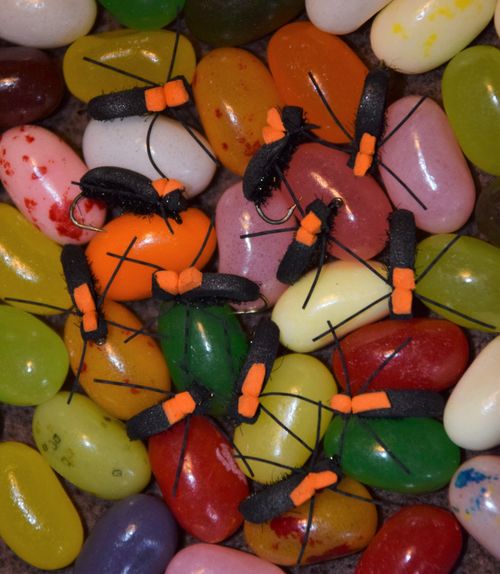
Jelly Bean Beetle

As the leaves begin to change colour and we transition into the fall fishing season, terrestrial insects remain an important food source for trout. Beetles are often present in large numbers along the banks of rivers and creeks and being clumsy fliers often end up in the water where they become an easy meal for a hungry fish.
This particular beetle imitation closely mimics a variety of beetle species in both profile and lustre. Beetle flies are very often hard to spot on the water, but this particular pattern has an indicator foam strip on its back to aid in seeing subtle rises or when your fly is dragging. This is a great fly to add to your box as it is easy to tie, easy to see, and trout rise enthusiastically to eat it.
Hook: Mustad 94840; Size 14
Thread: UTC Ultra 140; black
Shell: Black foam (2mm)
Underbody: Ice Dub; peacock black
Legs: Round rubber legs; small grey
Indicator: Orange foam (2mm)
Tying Instructions
Step 1.
Insert the hook in the vise, attach the thread and proceed to wrap a thread base down and back along the hook shank. End with the thread one eye width from the eye of the hook.
Step 2.
Cut a strip of foam that is approximately the width of the hook gap. Trim the corners of the foam strip into a point to aid with the tie in.
Step 3.
Apply a thin layer of Zap-A-Gap to the thread wraps. Place your foam strip on top of the hook shank with the pointed end at the thread index point. Bind down the pointed end of the foam strip with several wraps of thread.
Step 4.
Wrap back over the foam down into the curve of the hook bend securing it with spiral wraps; end with several overlapping wraps of thread. Insure that the foam strip is positioned horizontal to the hook bend.
Step 5.Create a tightly wrapped dubbing loop with the Ice Dub and then advance the tying thread to within two eye widths of the eye of the hook.
Step 6.
Proceed to wrap an underbody forward and tie off. Give the dubbed underbody a trim to eliminate any stray fibers, open up the hook gap and create the illusion of uniformity (I use a cauterizing tool to aid in trimming the really pesky fibers but be careful not to melt your foam!).
Step 7.
Pull the foam ‘shell’ over the top of the underbody and secure with several thread wraps at the front thread index point (two eye widths from the eye of the hook). Trim the excess foam strip leaving about 1/8” over the eye of the hook. This will form the head and body segments of the beetle.
Step 8.
Prepare a strip of 2 mm orange foam. This strip should be 1/2” long and about 1/8” wide. The orange foam indicator strip acts as a visual aid to help the angler see the drift of this low riding pattern. It also provides additional floatation for the pattern.
Step 9.
Secure the indicator strip to the top of the fly with 2 firm wraps of thread. Trim the orange foam indicator strip so that it forms a small V-shape and does not extend over the head of the fly.
Step 10.
Prepare a set of rubber legs by cutting an individual piece off the hank, folding it in half, and cutting. This should result in 2 roughly equal length round rubber legs.
Step 11.
Bind down the legs on both sides of the head/body tie in point with 2 or 3 thread wraps. Trim the legs so they are approximately a hook shank in length.
Step 12.
Place a small amount of Ice Dub on the thread, lift up the black foam head, and advance the thread/dubbing to the hook eye. Give this dubbed underbody a trim to eliminate any stray fibers and clear the eye. Be careful not to cut the legs!
Step 13.
Build up a small ‘head’ of thread and then execute a whip finish.
Step 14.
Carefully apply a small amount of Zap-A-Gap to the exposed thread wraps at the head of the fly.



